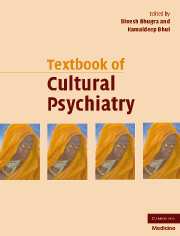Book contents
- Frontmatter
- Contents
- Contributors
- Foreword
- Preface
- Part I Theoretical background
- Part II Culture and mental health
- Part III Culture and mental disorders
- Part IV Theoretical aspects of management
- Part V Management with special groups
- Part VI Cultural research and training
- Cultural psychiatry: the past and the future
- Index
- References
Cultural psychiatry: the past and the future
Published online by Cambridge University Press: 11 August 2009
- Frontmatter
- Contents
- Contributors
- Foreword
- Preface
- Part I Theoretical background
- Part II Culture and mental health
- Part III Culture and mental disorders
- Part IV Theoretical aspects of management
- Part V Management with special groups
- Part VI Cultural research and training
- Cultural psychiatry: the past and the future
- Index
- References
Summary
Introduction
As is evident, cultural psychiatry deals with the relationship between culture and mental illness and how idioms of distress are portrayed and acknowledged within cultures. The role of cultures in moulding an individual's personality and growing up, along with social-support systems, determines not only the diagnosis of disorders but also management strategies. It is imperative that clinicians are as aware of cultural factors as they are of biological factors, which are also influenced by culturally determined patterns such as diet.
The future of cultural psychiatry will influence how psychiatric conditions present themselves and how help is sought. With changes in global movements of people, their ethnic and cultural identities will change and that will determine the distress and its expressions. The degree of change will be determined by a number of factors – individual personality traits, relationships and contacts within the kinship, and broader societal factors. The changes may be transient, semi-permanent or permanent.
Ethnic identity depends upon the cultural or physical criteria, which set the group apart and, wherever we go, we take our identities with us and with inter-racial marriages and relationships these will change. The ethnic group may set itself apart using superiority or inferiority on the basis of real or alleged physical characteristics (Feagin, 1978) and placed on cultural physical criteria which set the group apart (Thompson, 1989).
- Type
- Chapter
- Information
- Textbook of Cultural Psychiatry , pp. 561 - 568Publisher: Cambridge University PressPrint publication year: 2007
References
- 3
- Cited by

